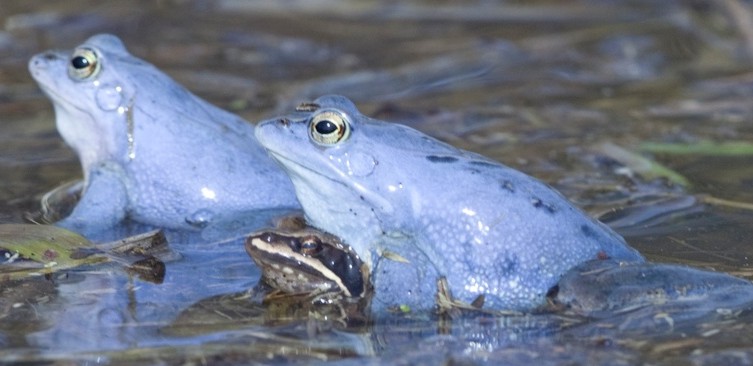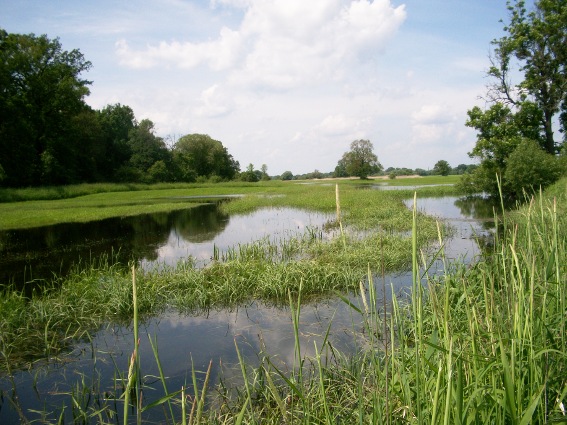Generation of floodplain landscaping guidelines for conservation of highly threatened amphibian species
Dissertation

Spawning moorfrogs, Foto: Andre Künzelmann/UFZ
Supervisor: PD Dr. Klaus Henle
PhD Student: Daniela Dick
Scholarship: Deutsche Bundesstiftung Umwelt - DBU
Duration: September 2009 - August 2012
Project description

The heterogeneous landscapes of natural floodplains are created by flooding and the following drought conditions. These dynamic habitats are hotspots of biodiversity and important dispersal corridors for a range of species, especially in the fragmented regions such as Central Europe. Here, up to 90% of the riverine landscapes are disconnected from the hydrological dynamics of the rivers and are in consequence degraded or lost as species habitats. During the last decade, flood events increased in strength and frequency, which caused a change of view in the European floodplain management. Recent approaches aim to combine interests in land use, human flood protection, and the conservation of biodiversity and ecosystem services. The impacts of floodplain modifications on the ecosystems have been mainly investigated on plants, fishes, and invertebrates. Surprisingly little attention has been paid on mobile semi-terrestrial species that directly respond to changes in the hydrological conditions in their habitats, such as amphibians. Due to their biology, most amphibian species depend on semi-terrestrial landscapes. The degradation and loss of suitable wetlands is a major cause of amphibian decline, globally as well as in Europe.
In my thesis, I investigated species-habitat interactions of amphibians in Central European floodplains.
My main purpose was the development of tools for amphibian conservation in floodplains. These tools included the formulation of general floodplain landscaping guidelines and a simulation model as conservation planning tool. A basic prerequisite was the summarising and the increasing of the little knowledge we had about amphibian ecology and community structures in Central European floodplain habitats.
Therefore, I collected the abundances of four representative amphibian species and 41 environmental variables within two years in the Upper Middle Elbe floodplain, Germany. This data was analysed in habitat models to identify (micro)habitat requirements of the species (project part 1). The data and the habitat model results were the basis for the development of the simulation model which demonstrates the response of an amphibian population to natural habitat dynamics as well as to anthropogenic floodplain modifications and conservation efforts (project part 2). The basic principles, which I developed from a literature analysis (project part 3), allow the generalisation of the habitat model results and the adjustment of the simulation model to other amphibian species and other floodplains. The formulation of floodplain landscaping guidelines for amphibian conservation based on the summarised results of all three chapters.
The results of this thesis outlined the complex habitat requirements of amphibians in Central European floodplains that need to be considered in conservation management. Identified microhabitat preferences were mostly species specific and the species showed temporal variability in habitat use related to the current hydrological conditions in the habitat. Species rich amphibian communities, which are typical for natural floodplains, depend on the heterogeneity of the landscape and the hydrological dynamics therein. The lack of floods may cause species shifts the loss of sensitive species which might be appropriate as indicators for naturally functional floodplains. In addition to the assessment of possible impacts of floodplain modifications of amphibian communities, the simulation model is directly applicable as conservation planning tool to assess the impacts of different management options on amphibian populations.
